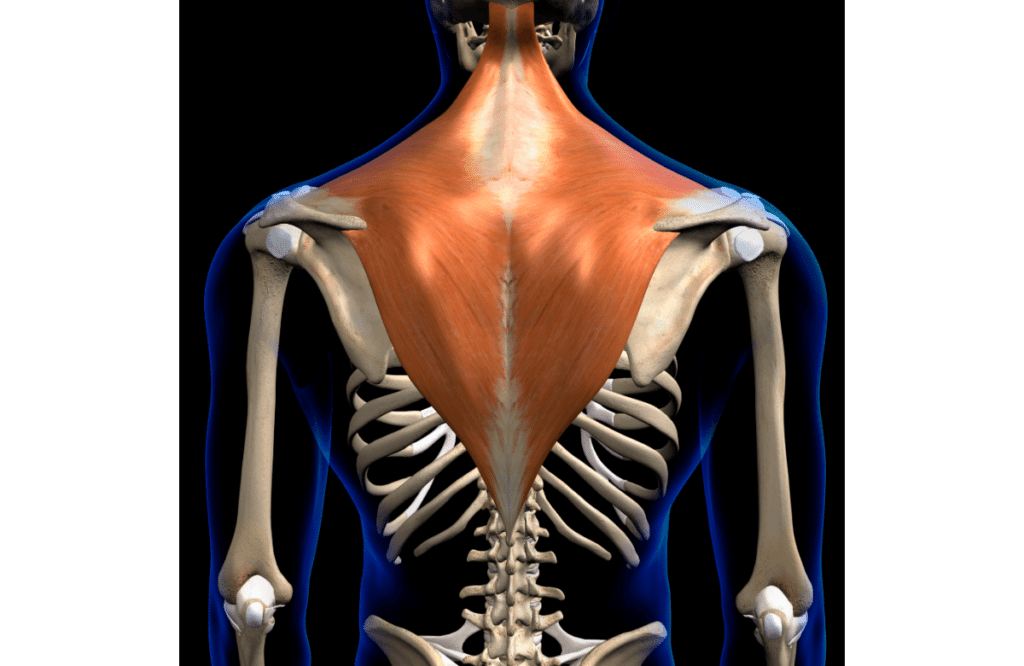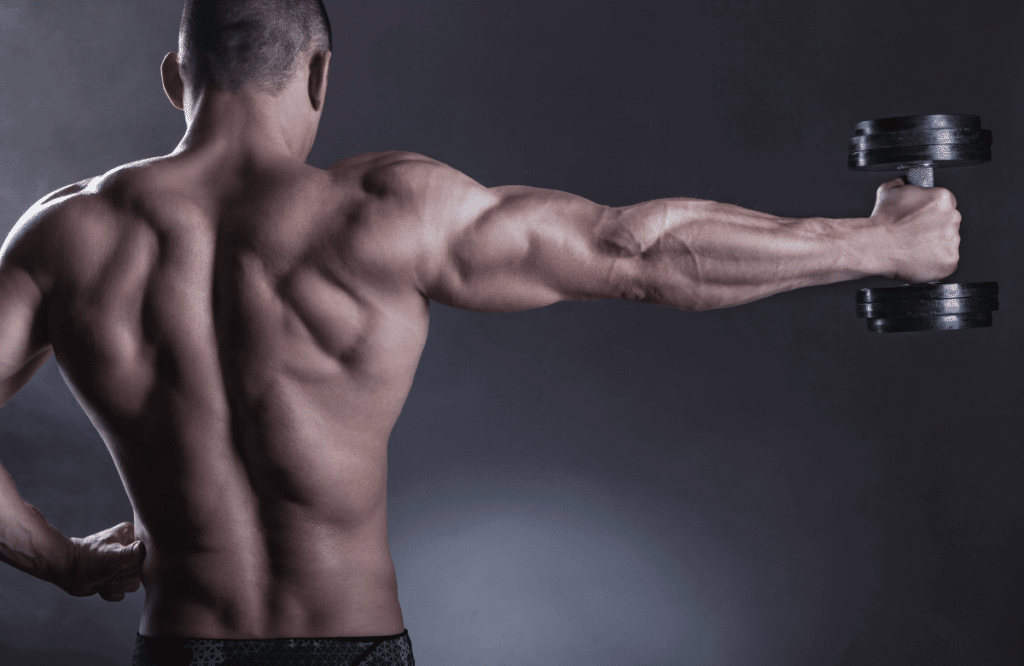Do you want to know how to build huge traps? In this article, we’re going to be looking at how to perform the 20 best trap exercises with perfect training techniques. But before we get into the proper form itself, let’s have a quick look at trap anatomy. Let’s get started.
Jump to:
- Anatomy of the Traps: What Are Trap Muscles?
- The Benefits of Training Your Traps
- 20 Best Trap Exercises
- 1. Shoulder Blade Squeeze
- 2. Prone Reverse Fly
- 3. Trap Bar Shrug
- 4. Barbell Shrug
- 5. Push-ups
- 6. Romanian Deadlift
- 7. Barbell Row
- 8. Dumbbell Row
- 9. Dumbbell Shrug
- 10. Cable Face Pull
- 11. Rack Pull
- 12. Overhead Barbell Shrug
- 13. Dual Dumbbell Overhead Carry
- 14. Scapular Pullup Shrugs
- 15. Snatch-Grip Barbell High Pull
- 16. Bent Over Y Raise
- 17. Farmer’s Walk
- 18. Floor Y Raises
- 19. Incline Dumbbell Shrug
- 20. T-Bar Row
- Trap Exercises: FAQs
Anatomy of the Traps: What Are Trap Muscles?
Firstly, with the shrug exercise, we are mainly targeting the upper trapezius levator scapulae muscles through scapular elevation.
So, basically just lifting your shoulder blades up you will also be performing the scapular upward rotation. Because we shouldn’t simply be shrugging the barbell straight up but also bringing the shoulders in closer to the neck. This is going to result in the shoulder joint rotating upward and actually being handled by the upper and mid traps exclusively.

The Functions of the Traps
Here are the functions of the traps:
- Scapular elevation: Upper trapezius levator scapulae;
- Scapular upward rotation: Upper trapezius;
- Scapular retraction: Trapezius.
So, the traditional shrug where you load the barbell up and just shrug it up seems to be a bit of a hit-or-miss common exercise. Some people feel a very strong upper trap contraction while others feel it mostly in the levator scapulae muscle more along the side of the neck.
In other words, the lower traps pull your shoulders down, the mid traps pull them back, and the upper traps elevate them.
Our Tip
The traps do scapular upward rotation more effectively than the other shrugging muscles. If your goal is to isolate the traps, you should be focusing on this scapular upward rotation component of the lift.

The Benefits of Training Your Traps
1. Reducing Neck Pain
Problems with the spine, injuries, and poor posture can all lead to upper back pain. Traps workouts prevent it, especially neck pain.
2. Improving Posture
Stronger trap muscles provide you with stability and help you maintain proper posture. They also increase muscular strength development in the areas surrounding your upper body.
3. Building Trap Muscles
Training the traps is the best way to increase hypertrophy in the upper back. It also provides you with better male body proportions.
20 Best Trap Exercises
The thing we want to clarify first: when it comes to the traps, it’s not just the upper traps. The things that connect your ears to your shoulders. If you are going to be balanced here, you have to remember the importance of the lower traps. With these 20 best exercises, you can hit your upper, mid, and lower traps.
1. Shoulder Blade Squeeze
Benefits of the Shoulder Blade Squeeze:
- It improves posture and stops shoulders from rounding forward;
- It reduces the risk of developing a shoulder impingement;
- It increases a limited range of motion.
How to Do the Shoulder Blade Squeeze:
Standing or sitting upright you’re going to use the resistance band. You can attach it to the door or the wall. What you’re going to do is you want to make sure that your head is in the right position, shoulders down, chest up, and stomach tight.
From here you’re going to go ahead and grab the band. And you’re going to pull from your upper back. Draw your shoulder blades together towards your spine. You should feel the upper back working. Think about bringing the shoulder blades down and together. You should feel that working the upper back.
Squeeze and hold the position. You’re going to hold that for about 5-10 seconds and then relax. You can also try holding the squeezed position for more of a challenge.
Slowly release and return to a normal standing position. Do about 15-20 repetitions of the maximum. This popular exercise can be performed either standing or seated on a sturdy chair.
Avoid shrugging throughout the movement. That is bringing your shoulders up towards your ears.
2. Prone Reverse Fly
Benefits of the Prone Reverse Fly
We’d highly suggest you add the prone reverse flies to your trap workout routine.
They will mainly emphasize the mid traps which will not only help with the overall aesthetic of your back but also help tremendously in terms of injury prevention and improving posture.
Multiple studies have found that the prone reverse flyes with external rotation such that the thumbs are pointing up elicits maximal activity of the mid-traps which is likely because of the way the mid-trap fibers run.
The line of pull of the arms should be most in line with the mid-trap fibers which run pretty much horizontally.
How to Do the Prone Reverse Fly
Simply lay on the floor or an incline or flat bench. With your thumbs pointing up, lift your arms straight out to your side. The goal is to feel a strong contraction in the middle of your back. In order to minimize upper trap action, avoid shrugging your shoulders up as you perform this common exercise.
We’d highly suggest that you start out without any weight and then gradually add weight over time as needed.
3. Trap Bar Shrug
The trap bar shrug automatically forces your arms into just about thirty degrees of abduction because you stand inside the bar frame. You don’t need to worry about the barbell rubbing up against the front of your body as you shrug.
We recommend loading the shrug in a more moderate rep range around 8-15 reps. Because loading the shrug more heavily will impair your ability to take the weight, especially at the top end of the range.
However, not everyone has access to a trap bar so in addition to that we’ll be covering the traditional barbell shrug in this article.
4. Barbell Shrug
Benefits of the Barbell Shrug
The barbell shrug is another wonderful exercise to include in your arsenal for trap building. It will mainly emphasize the upper traps. It seems to be one of the best upper trap exercises when it comes to activating and developing this region.
One study found that the shrug elicited the highest upper trap activity when compared to four other common upper trap exercises.
In addition to that, Bret Contreras analyzed the upper trap functions with 25 trap and shoulder exercises. And the barbell shrug was found to elicit the highest upper trap activity.
And as shown in this paper from the Journal of Clinical Biomechanics that analyzes the shrug, there are two things you can do:
- Perform the shrug with your hands shoulder-width apart. It increases the involvement of the upper trap muscle.
- You want to think about squeezing your shoulder blades together as you shrug up. Rather than just shrugging the weight straight up and down. The upper traps not only elevate the scapula but also retract it.
Common Mistakes:
- Rounded back;
- Protracted shoulders.
How to Do the Barbell Shrug
The best way to perform a barbell shrug and avoid both spinal flexion and rolled shoulders would be to position the barbell just a few inches below your hands.
Focus on a pause at the bottom and top of the movement. When you shrug the barbell, hold it for a second. Experience when an actual flex of your traps feels like, and then feel the stretch at the bottom when you lower the barbell. This is important if you want to build your mind-muscle connection. Once you master that, you can perform more advanced trapezius muscle exercises like the power shrug.
You don’t need to retract the shoulders as hard as you can during this excellent exercise, but you want to make sure your shoulders are slightly pulled back or at least sitting in a neutral position.
5. Push-ups
If you perform push-ups, your traps are really important. They control and stabilize your shoulder and scapular motions so that you can have the tension flowing through your chest muscles, shoulders, or triceps.
How to Do the Pushup
In order to get trapezius muscles in your push-up, you’re going to put your hands into a triangle position.
Take the hands down onto the mat, and come up into your push-up position. You can always bend the knees to modify it if you need to. Holding that push up you’re going to let your elbows come down into a bent position along your body and press back up.
Do as many as you can with good training techniques keeping the hips in alignment with your spine abdominis and breathing nice and easy.
6. Romanian Deadlift
Benefits of the Romanian Deadlift
The Romanian deadlift hits the traps back as a whole. Since it’s a multi-joint explosive movement, each part emphasizes a different area of the traps. At the very bottom, your torso is mostly horizontal so your mid traps activate in order to prevent your back from rounding.
How to Do the Romanian Deadlift
- Keep back straight;
- Push the hips back.
Common Mistakes:
- The bar loses contact with the legs;
- Reaching forward;
- Rounding the back and shoulders;
- Bending the knees too much.
7. Barbell Row
The primary muscle group we’re targeting with barbell rows obviously is the traps, or to be more specific middle and lower traps, as well as the rhomboids and lats.
The Starting Position
- Feet shoulder-width apart;
- Feet rotated outwards;
- Bar over mid-foot to the toe area.
How to Do the Barbell Row
- Keep back neutral;
- Hinge hips back;
- Slightly bend knees;
- Drive elbows up and back.
Common Mistakes:
- Pulling too much with the biceps;
- Bending knees too much.
8. Dumbbell Row
Benefits of the Dumbbell Row
One of the most fundamental compound exercises for training back and traps is the dumbbell row. The key to the dumbbell row is just making sure you get the most out of the move and you don’t create any lower back issues.
Set-Up
Your knee should be off the bench. Your hips, feet, and shoulders are squared up. Shoulders are slightly above the hips. Maintain your head in a neutral position.
How to Do the Dumbbell Row
- Tighten your shoulder blades to start each rep. You core is tight;
- Lead with your elbow as high as you can. Squeeze your traps and lat. Your forearm is simply a hook;
- Your lower back should not have any rotation.
Perform 3 sets of 8-12 reps per side start.
9. Dumbbell Shrug
Benefits of the Dumbbell Shrug
It’s one of the best upper trap exercises. This is because our traps are responsible for supporting the neck and elevating the scapula or bringing your shoulders to your ears, which we can see happening during every single repetition while performing the upper body movements.
There are a few form cues that can help you maximize the benefits of this power movement because it’s much more than just bringing your shoulders up and down.
How to Do the Dumbbell Shrug
The first thing you want to do is pick up a pair of dumbbells. And the best way to do it is you want to get yourself in the middle. You are going to sit down and pick up the dumbbells with your legs and then use your back to pick them straight up.
Keep your feet close together. You’re going to arch your back slightly and bring your shoulder blades together. Keep them tight. The whole time through the dumbbell shrug keep your arms and wrist straight making a neutral spine.
Breathe out as you elevate your shoulders up.
10. Cable Face Pull
Benefits of the Cable Face Pull
It’s a great isolation exercise to target your traps and you will get your rear deltoids within this exercise as well.
How to Do the Cable Face Pull
The correct way of doing this is first by putting a rope attachment on a high pulley of the cable machine.
You’re going to step away until the weight removes itself from the entire stack. And you’re going to pull up towards your head keeping your elbows out to your side not down to the bottom.
Wherever your elbows are pointing, that is the area of the back that you’re going to target. You don’t want to straighten your arms completely because then that will engage your biceps more. You just need to stretch out your traps, rhomboids, and rear delts and then pull back making sure the muscles are engaged the entire time.
You’re pulling the ropes apart at the top of the movement towards your head and then you’re bringing them in closer together once you reach the stretch portion.
11. Rack Pull
Benefits of the Rack Pull
There’s another solid exercise that can emphasize this area even more. That’s the rack pull. The reason this exercise is so effective for building new traps is quite simple. If you’re not spending energy lifting the bar from the floor, you’ll be able to further load the portion of the standard deadlift that activates the mid traps the most.
The heavier the weight, the more the traps are generally activated. The traps isometrically contract to resist your arms from being pulled out. This makes the rack pull an ideal option since you’ll be able to place the most amount of tension on the traps.
How to Do the Rack Pull
The goal is to work on your hip explosiveness and strength to increase your overall power on the deadlift.
Grab the barbell and make sure that the set-up is in the same form as your deadlift. Once in place take in a breath and squeeze your core as hard as you can to activate the internal belt. While keeping your core tight, explosively pull the barbell from the rack by pushing through your heels and extending your hips forward.
Hold the barbell at the top of the movement for a moment before returning to the starting position. As soon as you return the barbell to the rack, pause for a few seconds to reset and repeat.
The focus is to make sure that your rack pull form is the same as your deadlift form. If it isn’t, you will not receive the full benefit from the exercise.
Our tips:
- Keep the bar 1-2 inches below your knees. You don’t want the barbell to be too high or low;
- Your rack pull form must match your deadlift form;
- Start with 20-40 pounds more than what you would use for a normal working set of 8-10 reps on deadlifts.
- The pause between reps is extremely important. The goal here isn’t speed or endurance. It’s to increase your explosive power.
12. Overhead Barbell Shrug
Benefits of the Overhead Barbell Shrug
The overhead barbell shrug is a great opportunity to train the traps. Because during overhead activity your scapula needs to upwardly rotate. That upward rotation comes from the lower and upper traps. You need to make sure it’s happening functionally. You don’t want to just go and do a bunch of regular shrugs.
How to Do the Overhead Barbell Shrug
What you are going to do is lift the barbell up overhead. Hands are a little bit wider than shoulder width. From this position, you’re going to shrug.
13. Dual Dumbbell Overhead Carry
Benefits of the Dual Dumbbell Overhead Carry
Overhead carries with dumbbells add a significant challenge for traps. They are not fixed in the same way as a barbell so they require more stabilization. This stability requirement, and the demands on shoulder strength and flexibility make this carry surprisingly challenging.
How to Do the Dumbbell Overhead Carry:
- Actively push up against the dumbbells;
- Lock out the elbows;
- Squeeze the abdominal muscles.
While it may not be entirely possible depending on your flexibility, do your best to make sure that your arms are fully locked out overhead.
Performing the carry with the arms bent is far less stable and substantially more tiring.
14. Scapular Pullup Shrugs
Benefits of the Pull Up Shrug
With this exercise, you are going to strengthen your mid traps.
How to Do the Pullup Shrug
First of all, you need to know how the scapula moves. Relax and allow the stretch to happen. You are going to go into an active hand which is engaging through mid traps and setting the scapula in the right position for the pull-up.
There’s no elbow joint moving. Make sure that your ribcage is keeping the nice neutral line back.
15. Snatch-Grip Barbell High Pull
Benefits of the Snatch-Grip Barbell High Pull
You can focus on achieving a maximal explosion of the traps, ankles, knees, and hips because there is no need to worry about catching the barbell overhead.
How to Do the Snatch-Grip Barbell High Pull
You lower the bar to your knees and then you extend up and bring the barbell to the lower portion of the sternum using your arms and legs. It’s like you’re jumping but not leaving the ground.
The important thing is to keep the bar as close to the body as possible and use a powerful leg rise to get the barbell started.
16. Bent Over Y Raise
Benefits of the Bent Over Y Raise
It is one of the best lower trap exercises that target both the lower traps and rotator cuff muscles.
How to Do the Bent Over Y Raise
The starting position: stand with your feet shoulder-width apart. Tighten the abs and bend over at the hips keeping a neutral spine. With your thumbs pointing forward and palms facing in, let your arms hang straight down towards the floor.
From the standing position, begin the movement by retracting your shoulder blades. Just pull them together. Make sure you push them down.
To form a “Y” shape with your body, raise your arms at about a 30-45 degree angle from your torso as high as you can. Pause slightly at the top position and slowly lower your hands back down.
We recommend taking a nice big breath in while squeezing the shoulder blades. Start exhaling once you reach the top position with your arms.
There are two common mistakes to avoid:
- overarching the lower back;
- using too heavy loads you can’t control the movement with.
If you’re a beginner, you can start using only your arms without any additional weight.
You’ll definitely feel your lower traps after 15 reps.
17. Farmer’s Walk
Benefits of the Farmer’s Walk
In a similar way to how deadlifts hit the traps, the farmer’s walk forces the traps to resist the downward force of the weights you’re carrying. This isn’t just going to hit your traps but also some other superficial muscles, especially your forearms.
You can do this with a pair of dumbbells, a trap bar, or even with an actual farmer carry setup if your gym has the appropriate equipment.
While you are definitely going to be lifting heavy weight, it’s best if you start with light weights.
To track progress, simply note how many strides you take, the distance you travel, or even how long you walk.
If your forearm muscular strength development is limiting you, we recommend that you use chalk or wear straps.
The movements hit the traps isometrically meaning they’re activated without the traps shortening and lengthening.
How to Do the Farmer’s Walk
It’s as simple as picking up something heavy and walking around with it. But you need to keep in mind:
When you’re holding weight at your side, you want to be the one controlling the weight and creating the tension. You don’t want the weight controlling you.
18. Floor Y Raises
Benefits of the Floor Y Raises
It’s one of the best lower trap exercises to affect muscle growth and activate the muscle fibers of the lower traps. With that, you can improve your shoulder blade control, shoulder mobility, and posture.
How to Do the Floor Y Raises
Lie on your stomach. Your arms are fully extended and your thumbs are pointing up. Lift your arms as far as you can. Your core is tightened during the exercise. Your body should make the shape of the letter Y. Keep your arms straight. Pause at the top and return. Exhale when raising your arms, and inhale when dropping them down. Repeat.
19. Incline Dumbbell Shrug
Benefits of the Incline Dumbbell Shrug
This is a great way to build up the thickness of the traps. How is it different from just standing and shrugging? The line of pull is different on the traps. With the body bent forward and the arms hanging down, you are using more of your middle traps.
How to Do the Incline Dumbbell Shrug
The incline dumbbell shrug is basically done on an incline bench. You’re going to be face down on an incline bench doing shrugs. To do the exercise, we recommend using straps so that you are focused on pulling with the traps, not the hands.
You are going to place your lower chest at the top of the bench. Then let your arms hang straight down. Keeping your arms straight, you are simply going to shrug your shoulders up towards your ears. Then let your arms go back down.
It’s a short motion. Focus on squeezing your traps at the top position.
20. T-Bar Row
Benefits of the T-Bar Row
Many people use a t-bar row machine to focus on the lats. But if you reverse your grip and slide your chest up toward the top, you can target your lower trap muscles.
How to Do the T-Bar Row
Set up a barbell either in the corner of your gym or use a landmine attachment. Brace your core and get your hips back. Your lower back stays completely fixed during this motion. It’s only your arms that move up and down. Your shoulders can relax at the bottom. They can tighten up at the top and your lower back stays completely steady.
Trap Exercises: FAQs
What exercise works the traps?
There are a lot of compound exercises that work the traps. For example, shrugs and row variations.
What are 5 exercises for trapezius?
Here are the 5 best trap exercises:
– cable face pull
– scapular pullup shrugs
– farmer’s walk
– snatch-grip barbell high pull
– dual dumbbell overhead carry















